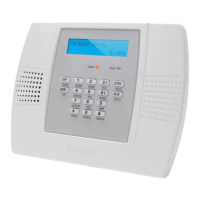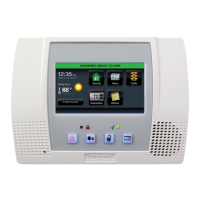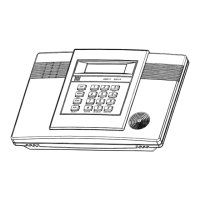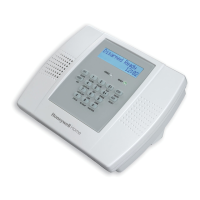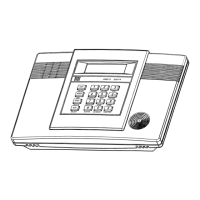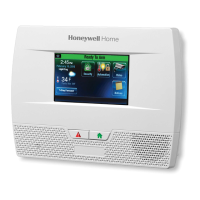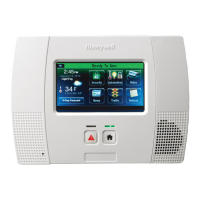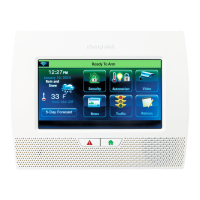–12–
Installing Wireless Zones
Transmitter Battery Life
•
Batteries in the wireless transmitters may last from 4–7 years,
depending on the environment, usage, and the specific wireless device
being used. Factors such as humidity, high or low temperatures, as
well as large swings in temperature may all reduce the actual battery
life in a given installation. The wireless system can identify a true low
battery situation, thus allowing the dealer or user of the system time to
arrange a change of battery and maintain protection for that point
within the system.
•
Button-type transmitters should be periodically tested for battery life.
The 5801, 5802MN, 5802MN2, 5804, 5804BD, 5804BDV, 5804E, and
5804WATCH button transmitters have replaceable batteries.
Using the Transmitter Sniffer Mode
Use this mode after all transmitters have been entered to check that all
transmitters have been properly programmed.
1. Enter
Installer code (4112) + [#] + 3.
O
N
O
F
F
5802MN
5804 /5804E
5801
01009-011-V0
1RWH
,I WKH FRPPXQLFDWRU LV LQ WKH SURFHVV RI VHQGLQJ D UHSRUW WR WKH FHQWUDO VWDWLRQ WKH V\VWHP ZLOO QRW JR LQWR WKH 6QLIIHU PRGH ,I VR ZDLW
D IHZ PLQXWHV DQG WU\ DJDLQ
2. The keypad will display all zone numbers, which have a non-zero Zone Type (even if serial numbers
were not learned yet). Fault each transmitter in turn, causing each one to send a signal. As the
system receives a signal from each of the transmitters, the zone number of that transmitter will
disappear from the display. The transmitters may be checked upon installation, or in an installed
system.
3. When all transmitters have been checked, exit Sniffer mode. Enter Installer Code (4112) + OFF.
1RWHV
6QLIIHU PRGH GRHV QRW DXWRPDWLFDOO\ H[SLUH <RX PXVW PDQXDOO\ H[LW ,QVWDOOHU &RGH 2)) 6QLIIHU PRGH WR UHWXUQ WR QRUPDO
RSHUDWLRQ
$OO %5W\SH XQLWV PXVW SK\VLFDOO\ EH DFWLYDWHG WR FOHDU WKH GLVSOD\ VLQFH WKH\ GR QRW DXWRPDWLFDOO\ VHQG FKHFNLQ VLJQDOV
:KHQ RQH EXWWRQ RI D WUDQVPLWWHU 5) 85 RU %5 LV DFWLYDWHG DOO ]RQHV DVVLJQHG WR RWKHU EXWWRQV RQ WKDW WUDQVPLWWHU DUH FOHDUHG
7KLV DOVR DSSOLHV WR DQG WUDQVPLWWHUV WKDW KDYH PXOWLSOH ORRSV ]RQHV
$Q\ WUDQVPLWWHU WKDW LV QRW ´HQWHUHGµ ZLOO QRW WXUQ RII LWV ]RQH QXPEHU
Go/No Go Test Mode
1RWH
(QFU\SWHG KLJKVHFXULW\ GHYLFHV PXVW EH DFWLYDWHG ZKLOH WKH V\VWHP LV LQ *R1R *R 7HVW 0RGH 5HIHU WR WKH WUDQVPLWWHU·V LQVWDOODWLRQ
LQVWUXFWLRQV IRU FRPSOHWH GHWDLOV
The Go/No Go tests will verify adequate RF signal strength from the proposed transmitter location, and
allow you to reorient or relocate transmitters if necessary, before mounting the transmitters permanently.
This mode is similar to the transmitter Test mode, except that the wireless receiver gain is reduced. This
will enable you to make sure that the RF signal from each transmitter is received with sufficient signal
amplitude when the system is in the normal operating mode.
1. Enter Installer Code (4112) + [#] + 8.
2. Once you have placed transmitters in their desired locations and the approximate length of wire to be
run to sensors is connected to the transmitter's screw terminals (if used), fault each transmitter.
&RQGXFWLQJ WKLV WHVW ZLWK \RXU KDQG ZUDSSHG DURXQG WKH WUDQVPLWWHU ZLOO FDXVH LQDFFXUDWH UHVXOWV
1RWH
2Q EXWWRQ W\SH WUDQVPLWWHUV WKDW KDYH EHHQ SURJUDPPHG WR VHW $50 $:$< $50 67$< RU ',6$50 SUHVVLQJ D EXWWRQ ZLOO WDNH WKH
V\VWHP RXW RI WKH *R1R *R 7HVW PRGH DQG FDXVH WKH SURJUDPPHG DFWLRQ
a. The keypad will beep three times indicating signal reception and will display the appropriate zone
number.
b. If the keypad does not beep, reorient or move the transmitter to another location. Usually a few
inches in either direction is all that is required.
4. If each transmitter produces the proper keypad response when it is faulted, you can then permanently
mount each of the transmitters according to the instructions provided with them.
5. Exit the Go/No Go Test mode by entering: Installer Code (4112) + OFF.

